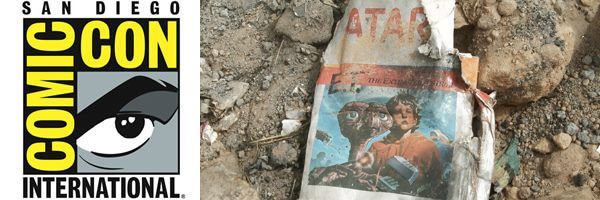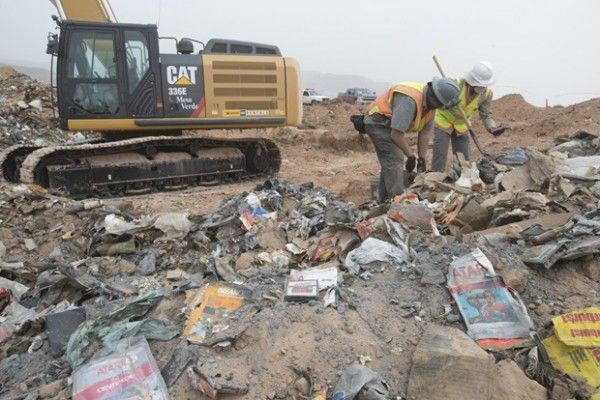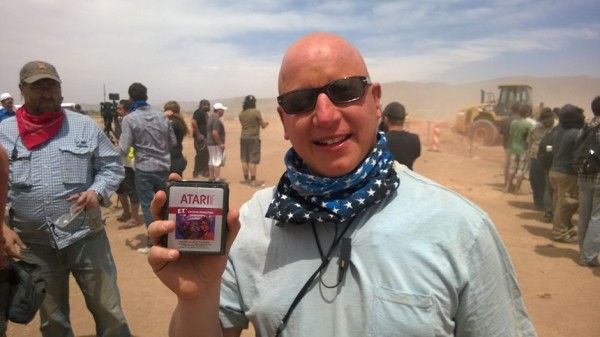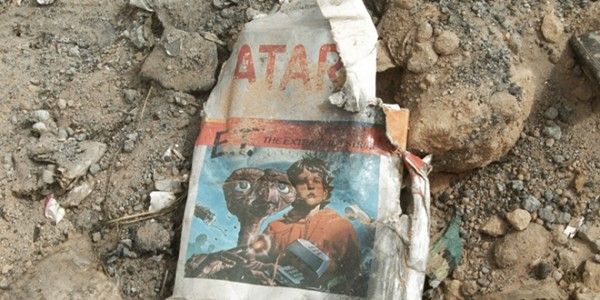Being an entertainment documentary junkie, I will watch any and everything I can get my hands on. I remember first hearing about the Atari / E.T. archaeological dig featured in Atari: Game Over, not knowing there was a film that was being created documenting the project. Besides, what was the angle for seekers of buried E.T. cartridges anyway? In a related vein, I was aware of prop collectors traveling to film locations to dig pieces of junk out of the desert that were once a part of Star Wars or Raiders of the Lost Ark sets. Many do this because they can get big bucks for rotten pieces of fiberglass and foam, simply because these unrecognizable bits and pieces were once a part of these important movies.
But seriously, one would think, who would want one of these old, once-buried E.T. cartridges anyway? Well, as I thought about it, I guess I would. Even though I never owned the Atari 2600, I still know it well as a milestone in gaming technology, and huge part of 70s and 80s culture. Then again, so was Steven Spielberg’s masterpiece E.T.. Actually, I found E.T. as disturbing as The Exorcist, but that’s a story for another time. The Comic Con panel described some interesting things about the new documentary Atari: Game Over that had to be heard to be believed. Hit the jump for highlights from Atari: Game Over Comic-Con panel recap.
The Comic-Con “Digging E.T.” program boasted that attendees would get a first glimpse of the Xbox Original documentary that chronicled the fall of the Atari Corporation through the lens of one of the biggest mysteries of all time, dubbed “The Great Video Game Burial of 1983.” This project had the involvement of all the right people, those who were actually there when it all went down: Atari’s founder Nolan Bushnell and the designer of the E.T. game, Howard Scott Warshaw.
There were so many issues that this documentary might uncover (pun intended) that I was fascinated to hear what the filmmaker’s angle would be. Would it be a pro-green, anti-landfill piece criticizing the burial of pop-culture fodder? Perhaps the frightening reality that an industry innovator such as Atari could become compromised due to one misfire product would be the real message. After all, E.T. solidified Spielberg’s place in cinema history, but this game may very well have destroyed Atari forever.
In attendance at the panel were filmmakers Simon Chinn and Jonathan Chinn, fuel CEO Mike Burns and director Zak Penn, as well as Atari founder Nolan Bushnell and game designer Howard Scott Warshaw. Moderated by Larry Hyrb, the panel was lively and candid, and began with a short clip of the documentary, briefly illustrating the beginnings of the Atari company accompanied by classic vintage commercial television footage and an excellent choice of music: “Thus Spoke Zarathustra.” It was smart of director Zak Penn to select a tech-friendly piece of music so psychologically associated with Stanley Kubrick’s vision of the future, 2001: A Space Odyssey (1968). The piece concluded with Howard Scott Warshaw recounting his first day at work at Atari, where he brought a joint because he had heard there was plenty of pot smoking there. Sadly, his new fellow employees laughed at him, saying that they were going to smoke “the real stuff,” whatever that meant.
This brief clip was everything it should have been, full of fun with a “no holds barred” attitude. Moderator Larry Hyrb kicked off the panel by asking how the Atari veterans had gotten involved with the doomed E.T. project. Warshaw discussed designing video games thusly: “the game was making the games.” It was also explained that E.T. was the fastest video game ever developed for a video game system. Atari got the call to develop E.T. on July 27th for an impossible September 1st deadline. It was against all odds, he explained, but the job was not turned down. E.T. had team of four people including Warshaw in total to design the game, including the music and everything else that goes into a video game, though Washaw said that he was the main man who did all the heavy lifting. It was a marathon for a five week turnaround, where six to eight months would have been the industry standard for designing a game at the time. At the end of the five weeks Steven Spielberg came to Atari to play the game, and simply made a half-hearted “ok” gesture after a few moments of play. He didn’t seem to inspired, and maybe he just kept thinking about the benefits of the high licensing fee he received for the game. Warshaw added: “I am proud to have designed the worst video game of all time.”
A legend arose that the game was released and then so hated by the public that it destroyed Atari, but that is not the reality. So, how did this story start in the first place? That’s the question Director Zak Penn chose to focus on in his film. His task: deconstructing a mythology.
Atari’s creator Nolan Bushnell remembered what changed Atari from a hip fun place of creativity to something less inspiring, candidly stating: “Warner Brothers got involved, and from day one, it was a fight. They were a pain in the ass, and eventually we parted company.” Warner Brothers restructured Atari, and in doing so ruined the magic within.
Semi-truck after semi-truck had delivered the cartridges to the dump after Atari’s fall, but most of the people in the town of Alamogordo, New Mexico did not know anything about it. Interestingly, the person responsible for burying the cartridges back in the day was involved in finding them all over again. With the advent of GPS, the disposal industry has become as sophisticated as the video game industry, but serious permissions and rights had to be granted to excavate the games. The landfill supervisor noted that there was only a small 30’ x 80’ hole to be found among the huge area of the dump, much like a treasure hunt. In the end, it was deemed nearly impossible to locate the games, and at one point documentary Director Penn asked himself: “how do I get off this project?”
Moderator Larry Hyrb mentioned that an hour was just not enough time to cover this enormous subject matter, and the hour panel went by in a flash. This documentary will hopefully uncover the mysteries of Atari’s downfall, as well as what was actually found in the legendary New Mexico landfill. During the panel filmmakers would not give away exactly what was found in the landfill, but did admit to finding some E.T. games there. Apparently, there were other items discovered in the dig as well, to be revealed in the documentary. One of the unearthed E.T. games, sealed up in a Ziplock bag, was given away to a Comic Con attendee during the panel. Penn asked the winner not to open it, otherwise the “horrible smell” would make him “puke.” In my opinion, the smell rotting plastic is quite unpleasant, but I would still want one of these E.T. treasures, regardless of the potential stench. You can’t write epic stories like this, and the tale that will be told in this documentary will end up becoming nothing short of pop-culture gold.




